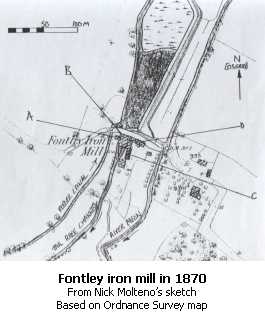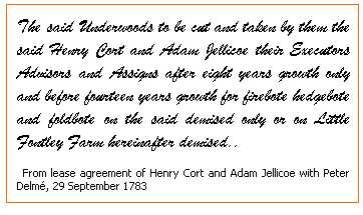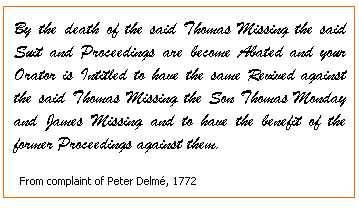 |
 |
Henry Cort Inventor - Creator of puddled iron - Father of iron trade |
 |
 |
| This page is part of a website based on the life and achievements of eighteenth-century inventor Henry Cort. The creator and owner of the site was Eric Alexander who passed away. The site is now hosted by Geneagraphie.com Please contact us with any comments or queries. |
- Homepage
- Life of Henry Cort
- Cort's processes in iron manufacture
- Cort's patents
- Refutation of allegations of conspiracies against Cort
- Adam Jellicoe's death
- Henry Cort's birth
- A navy agent's business
- Early life of John Becher
- Attwick & Burges families
- "Cortship" of second wife
- Thomas Morgan
- Henry Cort's hoops contract
- 1856 Accolade
- Generosity of friends 1789-94
- James Watson
- Illness of Cort's son
- Main sources of information
- Contemporary sources
- Navy sources
- Chancery files
- Publications about Cort
- Assessment of Cort's character
- Images of Henry Cort
Impeach-tranferred to 05
- Parliamentary inquiry 1811-2
- The furore of the 1850s
- Society of Arts
- Cort's first marriage
- Henry Cort's children
- Cort family pensions
- Henry Cort's Hertfordshire property
- 1791 signatories
- Guiana and the Cort-Gladstone connection
- Cort's twilight years
- Memorials to Henry Cort
- Smelting of iron
- Fining before Cort
- Shropshire & Staffordshire ironmasters
- Cumbrians: Wilkinson etc
- Early works at Merthyr Tydfil
- The Crowley business
- London ironmongers
- Scottish iron
- Cort's promotion efforts 1783-6
- Later Merthyr connections
- Puddling after Henry Cort
- Gosport in Cort's day
- Gosport administration
- Gosport worthies
- The Amherst-Porter network
- James Hackman, murderer
- Samuel Marshall
- Samuel Jellicoe's legacy
- Links with Titchfield
- Links with Fareham
- Fact, error and conjecture
- 18th century politics
- Law in the 18th century
- 18th century finance
- Religion and sexual mores
- Calendar change of 1752
- Shelburne, Parry and associates
- John Becher's family
- The Becher-Thackeray lineage
- Thomas Lyttelton: a fantastic narrative
- Eighteenth-century London
- Abolition and the Corts
- The Burges will tangle
- Navy connections
- Navy agent's business
- Cort's clients
- Ships' pursers
- History of Adam Jellicoe
- Dundas & Trotter
- Cort's navy office associates
- Toulmin & other agents
- Sandwich & Middleton
- The Arethusa
- John Becher's war
- Thomas Morgan's war
- The 1782 Jamaica convoy
- Sinking of the Royal George
- Visitors 2006-2009
- Developement of the site 2006-2009
- Daniel Guion and family
- Extremely bad academic work and extremely bad journalism
****************
|
|
Cort's links with Titchfield
 The Fontley site on the River Meon, generally recognised as Henry Cort's mill, is in the great Titchfield estate that once belonged to the Earls of Southampton. Built in the early seventeenth century, its forge was initially supplied with iron from a blast furnace at Sowley in the same estate (on the coast, west of Southampton Water). A family named Gringo (Quakers for much of the time) ran the mill from 1674 until 1773, by which time the estate was owned by the Delmé family.
The Fontley site on the River Meon, generally recognised as Henry Cort's mill, is in the great Titchfield estate that once belonged to the Earls of Southampton. Built in the early seventeenth century, its forge was initially supplied with iron from a blast furnace at Sowley in the same estate (on the coast, west of Southampton Water). A family named Gringo (Quakers for much of the time) ran the mill from 1674 until 1773, by which time the estate was owned by the Delmé family.
Fontley Iron Mill is also mentioned among features of a large tract of land leased from the Delmés by James Stares in 1771. Most accounts assume it is part of the Attwick business when Cort takes it over, but no evidence has been cited. One researcher cites a 1783 lease to Cort & Jellicoe.
 Descriptions of the site and what remains nowadays can be found in articles by M.D. Freeman and R.C. Riley in Industrial Archaeology 8 (1971), and in a 1998 dissertation by Nick Molteno.
Descriptions of the site and what remains nowadays can be found in articles by M.D. Freeman and R.C. Riley in Industrial Archaeology 8 (1971), and in a 1998 dissertation by Nick Molteno.
The Meon runs into the Solent at Titchfield Haven, several miles west of Gosport. The mill's location is about a mile upstream from Titchfield village.
When Cort first approaches Matthew Boulton in 1779, he is interested in getting an engine to pump water back from the mill's outflow to its head: a rotary engine for driving the millwheel directly is not yet available. One statement in the 1779 letter suggests that the mill Cort is referring to is on a different site, higher up the river: if more evidence supporting this idea emerges, this website will be adapted to accommodate it.
Cort never installs an engine at the recognised site. Here he finds he can increase his water supply by opening up a feeder canal, which traps water from two tributary streams lower down the valley and feeds it to the millpond. A map of 1610 shows this feature, which has probably become overgrown with vegetation by the time Cort arrives.
The mill's proximity to Titchfield brings Cort into contact with some of the locals.
 One of the most prominent is Asher Humphreys, steward of Delmé's estate, thus representative of Cort's landlord. His signature turns up repeatedly in orders summoning jurors to sessions of the manor court. In 1774 he gives his age as 63. Presumably he is instrumental in drawing up an indenture of 29 September 1783, by which a large tract of coppice land, including Little Funtley Farm, is leased to Henry Cort and Adam Jellicoe by Peter Delmé: this shows that a large quantity of charcoal is still being used at Cort's forge, apart from the coal needed for puddling.
One of the most prominent is Asher Humphreys, steward of Delmé's estate, thus representative of Cort's landlord. His signature turns up repeatedly in orders summoning jurors to sessions of the manor court. In 1774 he gives his age as 63. Presumably he is instrumental in drawing up an indenture of 29 September 1783, by which a large tract of coppice land, including Little Funtley Farm, is leased to Henry Cort and Adam Jellicoe by Peter Delmé: this shows that a large quantity of charcoal is still being used at Cort's forge, apart from the coal needed for puddling.
Associated with Humphreys in several documents is John Rickman. This name recurs to a confusing degree: there must be more than one, with connections in Titchfield, Portmouth, Gosport, Lymington and the Navy. One John Rickman, a navy lieutenant sailing with James Cook on his last expedition, has a particularly interesting career.

Another of Humphreys' associates is mercer Richard Lee (aged 67 in 1774), who has been "Bailiff and Revisor of Rents for the manors of Titchfield, Crofton and Newlands" since 1742. This post is closely linked to the steward's: no surprise to find him witnessing Humphreys's will.
Evidence about Humphreys's and Lee's ages comes from Delmé v Missing files at the National Archives, Kew. Delmé's complaint concerns members of the Missing family (four wills of different Thomas Missings can be found at Kew). The Shedfield property bought in 1767 by Adam Jellicoe has been in the Missing family since 1729: according to records of the house, two of the Missings who owned it were MPs; one of them also Mayor of Portsmouth, one a victualler to the Navy. The Missings deserve a book to themselves, but don't try searching for "Missing" in the catalogue at Kew: you will discover that hundreds of documents are missing!
|
Mr Missing having received the Kings Command by the Secretary at War to Victual Three Regiments going to Gibraltar He writes to Mr Scrope from Portsmouth by letter dated the 21st instant to acquaint my Lords that this Command coming in the Hot Season when Beef and Pork cannot be Kill'd or Cured to hold the Service, it is impossible to serve them according to the letter of the Contract, So is necessitated to exceed the limits thereof by packing Salt Provision at Such place or places where they are to be had soonest and his utmost Endeavours Shall be to obtain that of the best Quality and he will exert himself in hastening a way a proper Quantity of all Specie Suitable to the Augmentaco'n My Lords on this emergency acquiesce in Mr Missings request, but that he is to take care that the Letter of his Contract be Strictly pursued when the proper Season for Killing and Cureing comes in. From Treasury minutes, 27 July 1730 |
The John Missing who witnesses James Watson's 1777 wedding can be identified as the barrister and judge who has served as Recorder of Portsmouth from 1773 to 1775 (which brings him into connection with the Carter family, one of whom marries Adam Jellicoe's daughter Sarah). He is an associate of the Burges family - like Edward Ives, also of Titchfield, with whom there is a tenuous relationship by marriage.
 No children are named in this John's will, but the John Missing serving in the East India Company's army (who in 1802 will claim to have been a schoolfellow of Cort's eldest son) is named as a reserve beneficiary, in case closer ones die too soon.
No children are named in this John's will, but the John Missing serving in the East India Company's army (who in 1802 will claim to have been a schoolfellow of Cort's eldest son) is named as a reserve beneficiary, in case closer ones die too soon.
Another Titchfield name that deserves mention is Henry Cawte. Easy to confuse with our inventor, but this Cawte's name crops up in Titchfield records as far back as 1753.
Then there are Cort's employees at Fontley. John Bartholomew, who eventually takes over the mill, is local: so, probably, are Thomas Edmunds and John Swaine. (Further information about the Bartholomews, including some pictures of the mill, is available on a family website.) Henry Foxall and Thomas Llewellyn definitely come from outside the area.
In a letter that surfaces among the detritus of the 1812 inquiry, Llewellyn tells how his master, George Daniel at Penygored near Cardigan (where Cort is said to have given one of the earliest demonstrations of his puddling process) sent him to Fontley to find out more, and how he stayed for 6 months in 1785.
Foxall appears to have been an employee of Wright and Jesson at West Bromwich. He stays at Titchfield long enough to have one child baptised there. He is the one sent to Ketley, who later swears an affidavit about his experiences there. Other evidence shows him in Ireland in 1789. Later he becomes an important figure in America, running an iron foundry targeted by the British in the war of 1812. He also becomes important in the Methodist movement.
|
Related pages |
The pages on this site are copied from the original site of Eric Alexander (henrycort.net) with his allowance.
Eric passed away abt 2012
If you use/copy information from this site, please include a link to the page where you found the information.
